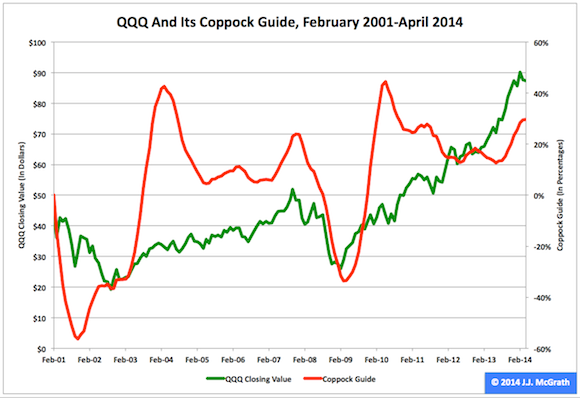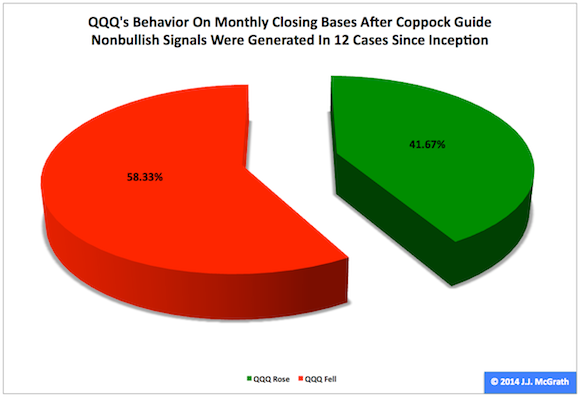The PowerShares QQQ (QQQ) is the 13th and final
exchange-traded fund featured in a J.J.’s Risky Business blog series centered
on the Coppock guide this month. Aka either the Coppock curve or the Coppock
indicator, the guide is a long-term indicator of price movements in major equity-market
indexes calculated on the basis of monthly data.
During the first third of this year, QQQ’s adjusted closing
share price dipped to $87.39 from $87.40, a drop of -1 cent, or -0.01 percent.
In the context of my work, the first 12 ETFs covered in my
Coppock guide blog series and QQQ are different in a couple of important ways,
as follows:
• First, the former funds are all derivatives of S&P
1500 subindexes, while the latter fund is a derivative of the Nasdaq-100 index.
• And, second, I monitor the first 12 funds through the
multiple metrics constituting my Daily Market Seismometer, while I track QQQ via
other metrics only periodically.
Nonetheless, I believe it is helpful to keep an eye (or two)
on QQQ, especially when the equity market appears to be approaching an
inflection point, as is the case now.
Figure 1: QQQ And Its
Coppock Guide, The Complete History
Note: The QQQ
closing-value scale is on the left, and the Coppock guide scale is on the
right.
Source: This J.J.’s
Risky Business chart is based on
proprietary analyses of Yahoo Finance adjusted monthly share-price data and those data themselves.
Edwin S. Coppock built his long-term guide not to flash both
bullish and bearish signals but to generate only bullish signals. However, I
employ it to produce either bullish or nonbullish signals. It is extremely
important to keep in mind that a nonbullish signal is not equivalent to a bearish signal in the context of the guide.
I anticipate QQQ may rise after a bullish signal and expect
it might do anything following a nonbullish signal (i.e., trade higher, lower
or sideways).
Figure 2: QQQ’s
Behavior Subsequent To Initial Bullish Signals
Source: This J.J.’s
Risky Business chart is based on
proprietary analyses of Yahoo Finance adjusted monthly share-price data.
The QQQ Coppock guide’s initial bullish signals collectively
have done a fair job in forecasting the future upward movements of the ETF on
monthly closing bases. In 12 cases since February 2001, these signals have been
successful on eight occasions, or 66.67 percent of the time, and unsuccessful
on four occasions, or 33.33 percent of the time.
The latest initial bullish signal flashed last June, when QQQ’s
closing share price was $70.38. Accounting for the one-month lag in the
confirmation of any signal, the ETF’s closing share price advanced to $87.39
this April from $74.82 last July, which clearly constitutes bullish action by
any standard.
Figure 3: QQQ’s
Behavior Subsequent To Initial Nonbullish Signals
Source: This J.J.’s
Risky Business chart is based on
proprietary analyses of Yahoo Finance adjusted monthly share-price data.
The QQQ
Coppock guide’s initial nonbullish signals collectively have compiled an
interesting track record since February 2001. Again, it is important to keep in mind a nonbullish signal
is not equivalent to a bearish signal
in the context of the guide. Following 12 initial nonbullish signals over the
years, the ETF’s share price on monthly closing bases fell on seven occasions, or
58.33 percent of the time, and rose on five occasions, or 41.67 percent of the
time.
Based
on the deceleration in the momentum of QQQ’s share price this year, I suspect
the Coppock guide may generate its next initial nonbullish signal by July 1.
Coppock Guide: The
Blog Series
Related Reading
Author’s Note: This is
the final blog post in a May series centered on the Coppock guides of 13
important ETFs, among them all nine Select Sector SPDRs and the three most popular
funds based on the constituent indexes of the S&P 1500. The first installment of the series was
cross-posted at both J.J.’s Risky Business and
J.J. McGrath’s Instablog on Seeking Alpha, but the rest of it was posted here.
Disclaimer: The opinions
expressed herein by the author do not constitute an investment recommendation,
and they are unsuitable for employment in the making of investment decisions.
The opinions expressed herein address only certain aspects of potential
investment in any securities and cannot substitute for comprehensive investment
analysis. The opinions expressed herein are based on an incomplete set of
information, illustrative in nature, and limited in scope. In addition, the
opinions expressed herein reflect the author’s best judgment as of the date of
publication, and they are subject to change without notice.



No comments:
Post a Comment